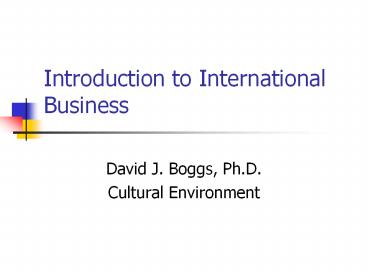Introduction%20to%20International%20Business - PowerPoint PPT Presentation
Title:
Introduction%20to%20International%20Business
Description:
Introduction to International Business David J. Boggs, Ph.D. Cultural Environment – PowerPoint PPT presentation
Number of Views:281
Avg rating:3.0/5.0
Title: Introduction%20to%20International%20Business
1
Introduction to International Business
- David J. Boggs, Ph.D.
- Cultural Environment
2
International Business and Globalization
- IB has grown rapidly and continues to grow
rapidly - Activities are diverse and taken for many
purposes - Different environment and activities than
domestic-only competition - More difficult, complex, and risky than domestic
business - In many industries it is no longer possible to be
just a domestic competitor
3
Culture
- Culture is the set of values, beliefs, rules,
and institutions held by a specific group of
people - It is learned and shared, its elements are
interrelated, and it defines group boundaries - Subcultures exist within larger cultural contexts
- One can acquire cultural literacy
- Ethnocentricity is a belief that ones own
culture is universally superior to others
4
Elements of Culture
- Aesthetics sense of beauty and good taste
- Art, color, symbols, music, folklore
- Attitudes and beliefs
- Time, directness, achievement, work, change
- Manners (appropriate behavior) and customs
(traditional behaviors)
5
Elements of Culture
- Education
- Literacy, science, math, trades, management
- Legal and political system
- Secular versus religious
- Free or not free
- Planned versus laissez-faire
6
Elements of Culture
- Societal organization
- Family structure, in-laws, extended family,
divorce - Class mobility
- Associations by age, gender, common interests, or
otherwise
7
Elements of Culture
- Language and communication
- Verbal and non-verbal
- Gestures and body language
- Office size and closed versus open doors
- Conversational distance
- Touching
- Protecting traditional languages
8
Elements of Culture
- Religious beliefs
- Christianity (Protestant, Catholic, Orthodox)
- Hinduism and Sikhism in India
- Sunni and Shia Islam
- Judaism
- Animism
- Atheism
- Confucianism, Taoism, Buddhism, and Shintoism in
Asia
9
Less Obvious Elements of Culture Observed by
Hofstede
- Individualism versus collectivism
- High/low power distance
- High/low uncertainty avoidance
- Desire for achievement/affiliation
- Long/short time horizon
10
Kluckhohn-Strodtbeck Framework
- Environment control, controlled by, or part of
- Time focus past, present, or future
- People control/dont trust or free/trust
- Purpose focus accomplishment, leisure, or
spiritual - Individual or group responsibility
- Public or private work and lives
11
Other Elements of Culture
- Trust
- Fatalism and locus of control
- High context/low context
- Idealism versus pragmatism
- Monochronic versus Polychronic
- Attitudes toward change
12
Culture Shock
- When placed in a foreign culture people tend to
experience culture shock, the frustration from
having to learn to cope with new cultural cues
and expectations
13
Stages of Culture Shock
High
Acceptance of New Culture
Low
Months Living in New Culture
14
Cultural Clusters
- Should cultures be defined by national borders?
15
Group Activity
- Describe American culture
- What elements of American culture might some
foreigners find strange? - Describe one foreign culture
- Describe ways that cultural differences can
affect business activities in particular
industries
16
Acquiring and Using Cultural Understanding
- Cultural awareness can be improved
- Companys need for cultural knowledge increases
as it - Moves from one to multiple foreign functions
- Increases the number of countries in which it
operates - Moves from similar to dissimilar foreign
environments - Converts from external to internal handling of
international operations
17
How does culture affect business?
- Work ethic
- Attitudes toward
- Time
- Supervisors and superiors
- Quality and reliability
- Rewards and promotions
18
Attitudes and Hiring Practices
- Ethnocentrism is the belief that all elements of
ones own culture are superior than the
corresponding elements of others cultures - Polycentric staffing involves hiring locals to
manage subsidiaries in each country and special
attention to each culture - Geocentric staffing involves hiring without
regard to cultural heritage or nationality
19
Need Hierarchy
- Lower-order needs must be fulfilled prior to
higher-order needs - Workers in poor countries motivated by
lower-order needs - People from different countries or cultures may
rank needs differently
20
Attitudes Toward Change
- The more a change upsets important values, the
more resistance it will engender attend to
attitudes and needs of culture - Consider the expected cost-benefit relationship
of any adjustments - Resistance to change may be lower if the number
of changes is not too great at any one time - Discussing proposed change with stakeholders in
advance may reduce resistance
21
Attitudes Toward Change
- Employees are more apt to support change when
they see its benefits and they expect personal or
group rewards - Change should be timed to occur when resistance
is likely to be low - International companies should learn things
abroad that they can apply at home































